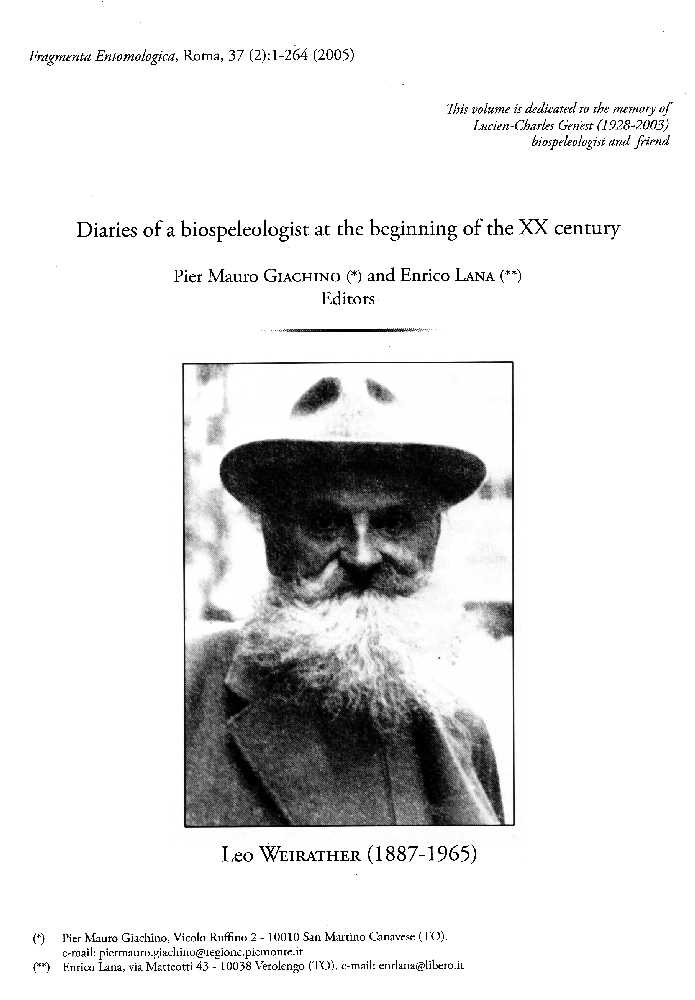
PREFACE
Leo Weirather, who was born in Brixen on 25th October 1887 and died in Innsbruck on 14th June 1965, was probably one of the greatest biospeleologists and explorers of the first half of last century; he left his work very early, retiring at only 52 years of age, so to devote himself entirely to biospeleological research and, in particular, to cave beetle fauna (Besuchet, 1969; Pretner, 1974).
At the beginning of last century, he worked as a postman in the Austro-Hungarian army at Trebinje in Herzegovina, from where, immediately after the first world war and following the collapse of the Austro-Hungarian empire, he moved to Innsbruck continuing his commercial activity of insect collector, but above all of biospeleologist explorer, being a profound expert of cave beetle fauna. Leo Weirather, in fact, lived in part selling the specimens he collected that were often prepared by his wife: some specimens of the series collected were sent to specialists for their identification and eventual description, the others were sold to the entomologists interested in them. He did not describe personally any of the several new species he collected, but he was in contact with the major specialists of the XXth century: Jeannel, Knirsch, Müller, Noeske, Reitter, Scheibel, Zariquiey, Winkler, ect. Probably it was the influence expressed by the biospeleologist Lucijan Matuliæ, during his sojour at Trebinje, to be the mainspring of Weirather's interest towards cave fauna, an interest that he cultivated for all his life, even after his return to Austria (Nonveiller, 1999). His collection was purchased in 1967, together with his archives, by the Museum d’Histoire Naturelle of Genève where it is currently preserved.
Weirather was undoubtedly one of the investigators of subterranean fauna of greatest success; we owe him, for example, the exploration, solely in Dalmatia, of about 500 caves and the discovery of 5 new genera and 79 species and subspecies of Coleoptera new to science (Pretner, 1974). His collecting travels were plenty, carried out it periods when travelling was surely uneasy, if not dangerous, in the Balcanic Peninsula, Crete, Anatolia and Italy, while before we knew only of his explorations in Dalmatia, favoured also by the presence of his wife's relatives in her country of origin (Šibenik), in 1925 (area of Dubrovnik), 1926 and 1927 (areas of Šibenik and Zrmanja), 1937 and 1939 (area of Šibenik) (Pretner, 1974; Nonveiller, 1999).
Weirather kept notes of his travels that, as Petar Novak wrote, he wanted to use in future for drawing up a catalogue entitled "Fauna Endemica" (Pretner, 1974; Nonveiller, 1999). This catalogue was never published, but Weirather's original notes, written in shorthand German, were translated into German by Egon Pretner (1896 – 1982) a famous Slovenian biospeleologist. Pretner realized three copies of the original typewriting: he kept one for himself, while he gave the other two to Lucien-Charles Genest (1928 – 2003) of Grenoble (France) and Vassil Borissov Guéorguiev (1935 - 1996) of Sofia (Bulgaria) after their promise not to popularize them until after his death, as they contained information about Yugoslavian caves, at that time under military secret (Genest & Guéorguiev, 1990 com. pers.). Before his death Pretner handed over to Guéorguiev his copy of Weirather's diaries, together with several new species of Leptodirinae (Coleoptera Cholevidae) still to be described; Genest's copy was given by him to P.M. Giachino in 1997, while the two copies held by Guéorguiev reached Giachino in 1996, together with the archives, after his death.
The very rich set of data, the indispensability of the news to find the visited caves included in these writings, the great diffusion of the material collected by Weirather in the most important specialistic collections and, not in the least, the wish to keep a promise made to our friends Lucien Genest and Vassil Guéorguiev, finally convinced us to attend to the translation into English and to the publication of the diaries.